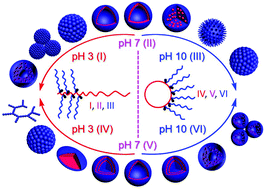Despite tremendous progress in macromolecular self-assembly, the influence of topology and hydrolysis on hierarchical self-assembly has been scarcely revealed. This study aims at the design of toothbrush-like copolymers with linear and cyclic backbones to reveal multi-tunable properties, and the introduction of pH/oxidation-responsive and hydrolyzable Y junctions endows the copolymers with unique hydrolysis-induced topological and morphological transformations. The cyclization of the polymer backbone can lead to distinct bulk and solution properties such as chain relaxation, solution viscosity and self-assembly, revealing the crucial role of cyclic architecture. Upon pH and oxidation stimuli, at least eight kinds of distinct nanostructures involving spheres, vesicles, disks and sea urchins are achieved by self-assembly. Hydrolysis-induced (co)assembly dependent on topology, pH and hydrolysis time offers programmable formation of a diversity of nanostructures. Both toothbrushes can self-assemble into unilamellar vesicles, while the vesicles bearing cyclic toothbrushes are readily converted into double-lamellar vesicles upon heating, sonication and short-time pH stimulus. Our research can provide new insight into topology-related formation and transition processes of polymer nanoparticles. The success of this study paves the way for macromolecular engineering towards promising shape-dependent properties and applications.
